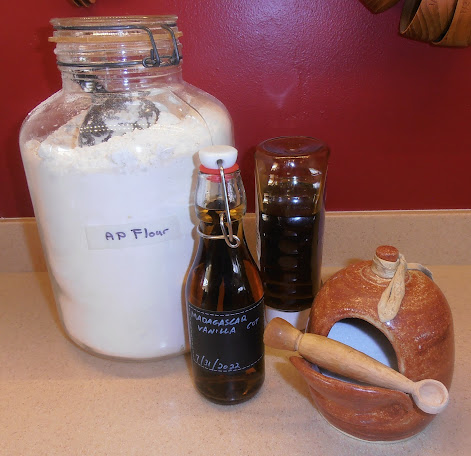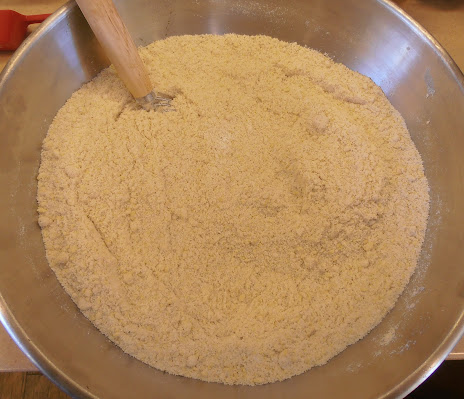I was studying the food opportunities (or lack thereof!) of people who traveled steerage class in the 1800s and early 1900s, when I came across a recipe that caught my attention. It is from The Ellis Island Immigrant Cookbook, written by Tom Bernardin. Click here to find it online. Mr. Bernardin worked at the Statue of Liberty and Ellis Island Immigration Museum sites, giving tours and developing a slide show on the history of Ellis Island which he presented many times. In the process, he decided he needed to gather the recipes from the immigrants, employees, and their families. His book was the result of these efforts.
 |
| ISBN: 0-9629198-4-5 |
His recipes came from 33 countries and often were accompanied by stories from the person who sent them, telling about the immigrant family member or the memories they had of the food. As someone who is interested in food history, I marvel at the old methods of cooking contained in these recipes. For example, one called "Biscuit de Reims" starts with:
Take 9 eggs and weigh them and take the same weight in sugar.
Take 6 eggs and weigh them and take the same weight in flour.
Take 3 eggs and weigh them and take the same weight in butter.
We don't think about measuring that way, but imagine a person who cannot determine in advance how much an egg from her hens would weigh. Also keep in mind that standardized measurements were not common until the early 1900s (thank you, Fannie Farmer!), but using the weighing method - no matter what unit you worked in - should work.
The recipe I choose to make is called Mustasole, which is probably a spelling variant of Mustazzoli or Mostaccioli. It is possible the name originated from the Roman words meaning "cake made with must." Must is freshly squeezed, unfiltered grape juice; sometimes it is cooked to concentrate the flavors and intensify the sugars, and this is called "saba."
This recipe is made with honey, so the flavor profile would be different than one using must. The final goal is to make a cookie that is hard when dry but soft when moist, lasts for months or even years without spoiling, and does not make crumbs.
On page 116, we find mustasole recipe along with a reminiscence from the contributor, Ms. Saiia, revealing how her family and others used these cookies for nutrition on the sea voyage.
Mustasole
3 cups sifted all-purpose flour in a bowl
1 1/2 cups sifted all-purpose flour in a cup
1 1/2 cups melted honey, warm
1/4 teaspoon salt
1/2 teaspoon vanilla or lemon flavor
Place 3 cups flour in bowl, add hot honey, salt, flavor and mix well. Add more flour to make very stiff dough, knead on a board till smooth. Place in bowl and cover and let rest for at least 12 hours, not in refrigerator. Divide in 4 pieces - knead each till smooth, using little flour. Shape as you would children's clay - build on ungreased cookied sheets - add little oil on top and shine, or water to make it stick. Bake at 325 degrees for 15 to 20 minutes (gas or electric varies) till golden brown. Remove from pan while hot and lay on flat surface to harden. (Limp when hot - hard when cold.) No crumbs.My Notes
I chose to use vanilla, although the lemon had me intrigued.
I heated the honey in the microwave for about 1 1/2 minutes, so it was hot and very liquid.
I mixed all the ingredients in the bowl with a spoon until the dough was not as sticky. Then I moved it to the cutting board that was dusted with flour. I kneaded it by hand, adding flour, until the dough was smooth, firm, and not sticky when touched quickly. I noticed that when the dough sat for a minute or two, it started to stick to the board.
The bowl for resting was lightly dusted with flour and I put the dough in that. I covered it with a cloth and let it rest for 30 hours (it was a busy time!).
There was about 3/4 cup of flour left of the 1 1/2 cups. Flour can absorb different amounts of liquid depending on when the wheat was harvested or ground or how old the flour is, so having this extra was good.
 |
| Stirred with extra flour added. Ready for kneading. |
 |
| Kneaded and ready for a rest. |
 |
| For the thick. |
 |
| For the thin! |
 |
| Thick. I didn't think they would spread, but I was careful anyway. |
 |
| Thin. Crowd them together! |
 |
| Baked thick. |
 |
| Baked thin. |
The Verdict
 |
| Liberty cookies! |
 |
| The thick one, cut open to show the texture. |
This recipe is very similar to the lebkuchen cookies I made previously, following a medieval recipe. Click here to view it. It took a few tries to get it successful, so click here to see the other post on it. Basically, they are same, but lebkuchen has spices added to it. Since the lebkuchen dough can sit in a container for years (supposedly with improvement), I didn't worry about the mustasole sitting on the counter for 30 hours. I would say the mustasole has less sweetener in it, but that is just a guess. Both mustasole and lebkuchen are traditionally frosted with a chocolate glaze, if decorated at all.










































